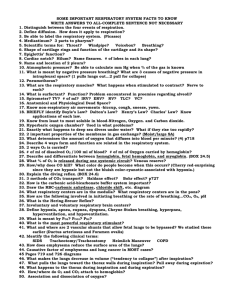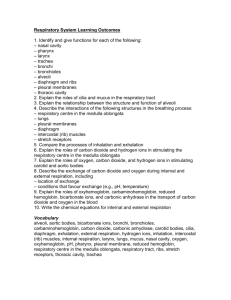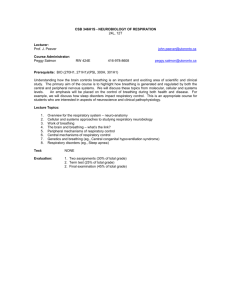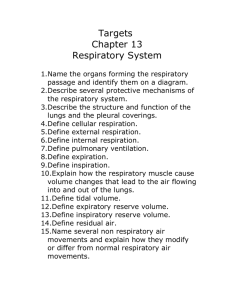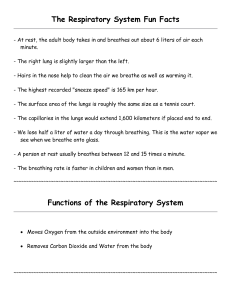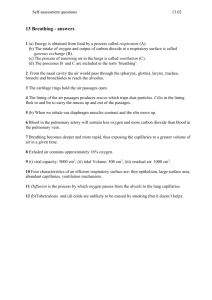Ch. 16 Respiratory System - YISS-Anatomy2010-11
advertisement
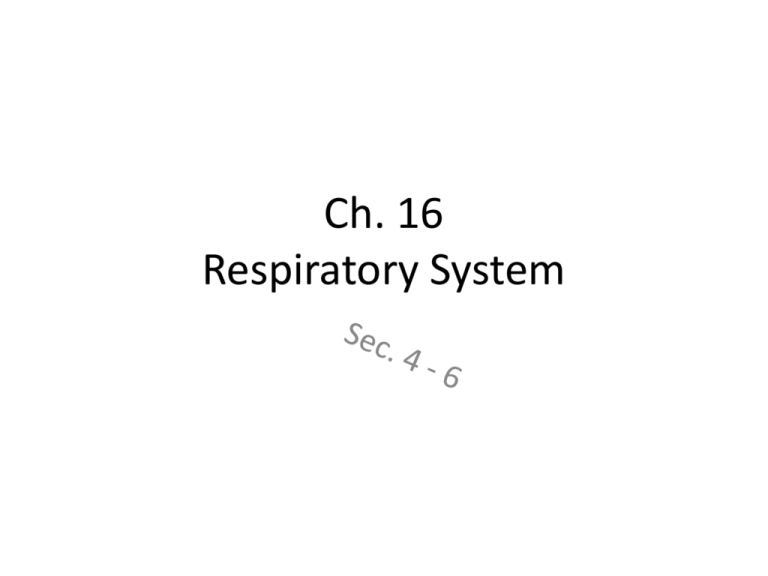
Ch. 16 Respiratory System 16.4 Control of Breathing • Normal breathing is a rhythmic, involuntary act that continues even when a person is unconscious. • The respiratory muscles are under voluntary control. Respiratory Center • In the brainstem • Control both inspiration and expiration. • Neurons scatter though out the pons and medulla oblongata. Medulla: rhythmicity area Pons: pneumotaxic area Medullary rhythmicity Area • Two neuron groups that extend the length of the medulla oblongata. 1: Dorsal respiratory group 2: Ventral respiratory group 1. Dorsal respiratory group -controls the basic rhythm of inspiration -neurons emit bursts of impulses that signal the diaphragm and other inspiratory muscles to contract. -start out weak and then stengthen and then suddenly stops. The breathing muscles that contract in response to the impulses steadily increase the volume of air entering the lungs. -neurons remain inactive during expiration. Then start to inspire again. 2. Ventral respiratory group -quiet during normal breathing. -neurons generate impulses that increase inspiratory movements during forceful breathing. -neurons activate muscles that are needed during forceful breathing. • Neurons in pneumotaxic area of the pons continuously transmit impulses that inhibit the inspiratory bursts originating from the dorsal respiratory group. • Control breathng rate. • Strong neuron bursts, breathing rate increases. Factors Affecting Breathing • Chemosensitive areas (chemoreceptors) – ventral portion of the medulla oblongata, sense changes in the cerebrospinal fluid (CSF). • Concentrations of carbon dioxide and hydrogen ions. • If concentrations rise, the central chemoreceptors signal the respiratory center, respiratory rate and tidal volume increase. • Result --- more carbon dioxide is exhaled. Hyperventilation • Breathing rapidly and deeply. • Lowers the blood carbon dioxide concentration. • After hyperventilation, it takes longer than usual for the carbon dioxide concentration to stimulate the urge to breath. • *this can cause abnormally low blood oxygen levels. • This should never be done to help hold breath during swimming --- could lose consciousness underwater and drown. 16.5 Alveolar Gas Exchanges • Many capillaries on the alveolus wall. • Respiratory membrane – between blood and alveolar air exhange, two layers of epithelial cells and a layer of fused basement membrane. • Consists of the wall of the alveolus and the wall of the capillary. • http://www.youtube.com/watch?v=DoSTehS7i q8&feature=player_embedded Diffusion Across the Respiratory Membrane • Partial pressure: amount of pressure each gas contributes in a gas mixture. • Air – Oxygen 21% (21% of 760 mm Hg or 160mm) = Po2 – Carbon dioxide Pco2 = 0.3mm Carbon dioxide diffuse from blood where its partial pressure is higher. (40mm hg) Oxygen in alveolar is 40mm hg so enters into blood. 16.6 Gas Transport • Oxygen transport – 98% of oxygen in blood bind to the iron-containing protein hemoglobin in RBCs. – Remainder dissolve in plasma. – Hemoglobin + oxygen = oxyhemoglobin – Unstable bond between hemoglobin and oxygen. – When pressure decreases oxyhemoglobin releases oxygen, which diffuses into nearby cells. • More oxygen is released as the blood concentration of carbon dioxide increases. • As blood become more acidic, or as blood temperature increases. • Explains why more oxygen is released to skeletal muscles during physical exercise. • Increase in carbon dioxide, decrease in pH, and raise temp. • Hypoxia – deficiency of oxygen reaching the tissues. • Hypoxemia – decreased oxygen in blood. • Anemic hypoxia – diminished ability of the blood to transport oxygen. • Ischemica hypoxia – inadequate blood flow. • Histotoxic hypoxia – defect at the cellular level. – Ex. Cyanide poisoning • http://www.youtube.com/watch?v=WXOBJEX xNEo&feature=player_embedded#at=44 Carbon Dioxide Transport • CO2 + hemoglobin = carbaminohemoglobin • Forms slowly • Only 23% of the carbon dioxide that blood transports is in this form. • Another transport mechanism is the formation of bicarbonate ions (HCO3-). • CO2 reacts with water for form carbonic acid. • Carbonic anhydrase-speeds the reaction between carbon dioxide and water. • http://www.youtube.com/watch?v=x26TWL3 VKMg&feature=player_embedded


